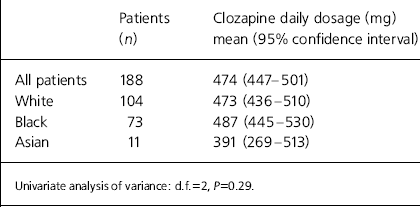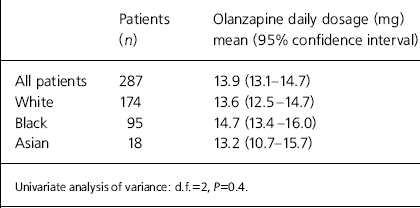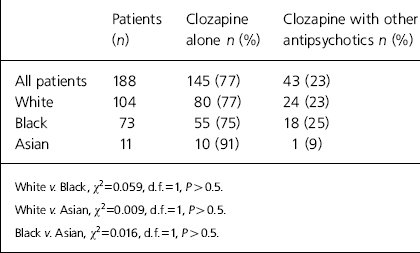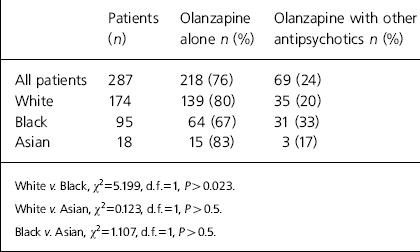Ethnicity is an important influence on the drug treatment of psychosis and schizophrenia. Two major factors have been noted (Reference Bhugra and BhuiBhugra & Bhui, 1999); the various interpretations of culturally influenced behaviours, and their effect on treatment choice and dosage; and the variation in drug dosage that arises as a consequence of the different metabolic capacities found in different racial groups.
Differences in therapeutic dosage between races have been noted for several antipsychotic drugs. For example, the therapeutic dosage of chlorpromazine in Asian patients appears to be around half that needed in White patients (Reference Lin and FinderLin & Finder, 1983). The therapeutic dosage of haloperidol also seems to be lower in Asian than in White patients (Reference Lin, Poland and NuccioLin et al, 1989), probably because of reduced metabolic capacity in Asian people (Reference Chang, Jann and HwuChang et al, 1991; Reference Zhang-Wong, Beiser and ZipurskyZhang-Wong et al, 1998). In fact, haloperidol metabolism has been shown to be different in White, Chinese, Hispanic and Black populations (Reference Jann, Chang and LamJann et al, 1993).
For clozapine, racial differences in metabolism have been noted for White compared with Chinese patients (Reference FarooqFarooq, 1998; Chong, 1998). Differences in response to clozapine have been reported in Korean Americans and Caucasians (Reference Matsuda, Cho and LinMatsuda et al, 1996), differences which may have been a result of different pharmacokinetics, pharmacodynamics, or both (Reference Masellis, Basile and ÖzdemirMasellis et al, 2000). Also, clozapine-related agranulocytosis may be more common in Asians than in Whites (Reference Munro, O'Sullivan and AndrewsMunro et al, 1999). With olanzapine, no report of racially determined differences in dosage, response or metabolism could be found. There is no report of variation in antipsychotic co-prescription according to race for clozapine or olanzapine.
This study was designed as a pilot investigation of the existence and extent of differences in rates of polypharmacy and in dosage of clozapine and olanzapine according to ethnic origin.
Method
In February 2002, all in-patient prescription charts in the South London and Maudsley National Health Service (NHS) Trust were examined, and patients prescribed clozapine and olanzapine were identified. For these patients, prescribed dosage was recorded and the medical notes were examined to determine patients’ documented ethnic origin. Ethnic group was categorised under the following headings: White; Black (Black Caribbean, Black African and Black other); Asian (Indian, Pakistani, Bangladeshi, Chinese, other Asian); and Unknown (i.e. not recorded in notes). All other drugs prescribed were also recorded, as was patient gender and age. Data were analysed using the Statistical Package for the Social Sciences version 7, for Windows.
Results
A total of 1441 prescriptions were screened. Of these, 328 were for olanzapine and 200 for clozapine. Ethnic grouping could be determined for 287 patients prescribed olanzapine and 188 prescribed clozapine.
An analysis of patient demographic characteristics is given in Table 1. Results of the statistical analysis for clozapine were: age, univariate analysis of variance (ANOVA), d.f.=2, P=0.41; gender, χ2=1.26, d.f.=2, P>0.5. For olanzapine, results were: age, (ANOVA), d.f.=2, P=0.27; gender, χ2=1.41, d.f.=2, P>0.1. There was no significant difference between ethnic groups in age or gender for either drug.
Table 1. Demographic characteristics of the patients studied

| Age (years) Mean (range) | Male (%) | |||||
|---|---|---|---|---|---|---|
| Drug | White | Black | Asian | White | Black | Asian |
| Clozapine | 38.5 (21-80) | 33.6 (22-62) | 32.3 (24-40) | 72.7 | 78.6 | 77.8 |
| Olanzapine | 44.0 (16-93) | 38.0 (18-77) | 27.0 (16-35) | 74 | 70.1 | 66.7 |
Dosage
The mean recorded daily dosages for clozapine are shown in Table 2, and those for olanzapine are given in Table 3. Neither drug showed any significant difference in dosage according to race.
Table 2. Clozapine dosage

| Patients (n) | Clozapine daily dosage (mg) mean (95% confidence interval) | |
|---|---|---|
| All patients | 188 | 474 (447-501) |
| White | 104 | 473 (436-510) |
| Black | 73 | 487 (445-530) |
| Asian | 11 | 391 (269-513) |
Table 3. Olanzapine dosage

| Patients (n) | Olanzapine daily dosage (mg) mean (95% confidence interval) | |
|---|---|---|
| All patients | 287 | 13.9 (13.1-14.7) |
| White | 174 | 13.6 (12.5-14.7) |
| Black | 95 | 14.7 (13.4-16.0) |
| Asian | 18 | 13.2 (10.7-15.7) |
Co-prescription with other antipsychotic drugs
The rates of co-prescription with other antipsychotic drugs are shown in Table 4 for clozapine and in Table 5 for olanzapine. There was no significant difference in rates of co-prescription according to ethnicity for clozapine, but for olanzapine, White patients were significantly less likely than Black patients to be co-prescribed regular antipsychotics (P=0.023).
Table 4. Clozapine co-prescription rates

| Patients (n) | Clozapine alone n (%) | Clozapine with other antipsychotics n (%) | |
|---|---|---|---|
| All patients | 188 | 145 (77) | 43 (23) |
| White | 104 | 80 (77) | 24 (23) |
| Black | 73 | 55 (75) | 18 (25) |
| Asian | 11 | 10 (91) | 1 (9) |
Table 5. Olanzapine co-prescription rates

| Patients (n) | Olanzapine alone n (%) | Olanzapine with other antipsychotics n (%) | |
|---|---|---|---|
| All patients | 287 | 218 (76) | 69 (24) |
| White | 174 | 139 (80) | 35 (20) |
| Black | 95 | 64 (67) | 31 (33) |
| Asian | 18 | 15 (83) | 3 (17) |
Discussion
This pilot study revealed only one difference in prescribing variables that might be related to ethnic origin: antipsychotic polypharmacy was more common in Black patients than in White patients in those receiving olanzapine. All other parameters suggested no important or significant difference between ethnic groups.
These results suggest that there are few important differences related to patient ethnicity in prescribing practice for clozapine and olanzapine. However, the study had two major shortcomings. First, the sample size was limited by the availability of patients and of data relating to patients. This meant that the study's power to detect differences - should they have existed - was somewhat limited. This is particularly true for comparisons involving Asian patients, for whom differences were often substantial but the small number of patients meant that such differences were not statistically significant. Second, diagnosis was not recorded. Diagnosis is likely to have an important effect on prescribing practice, and so the absence of diagnostic data to some extent diminishes the validity of results obtained. These two observations make precise interpretation difficult. Nevertheless, the absence of any clear difference in dosage prescribed for White and Black patients strongly suggests that their ethnicity did not play a part in prescribing decisions in this regard.
The observation that polypharmacy with olanzapine and other antipsychotic drugs was more common in Black than in White patients requires further investigation. It is also noteworthy that there was something of a trend for higher dosage to be used in Black patients; further study is required to expand on these preliminary observations. Such studies should involve larger numbers of participants, and also should record other influences on prescribing, such as diagnosis, body weight and history of illness or violence.








eLetters
No eLetters have been published for this article.